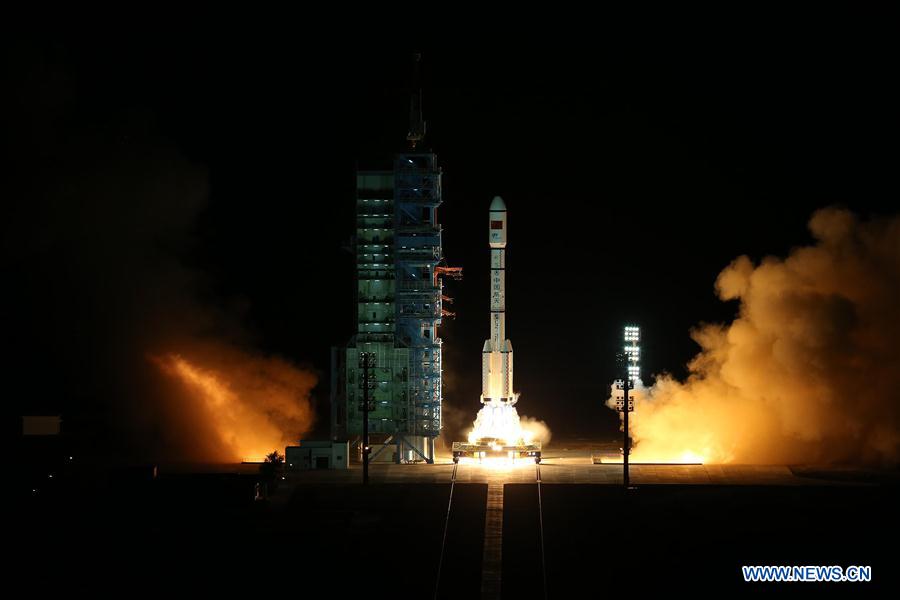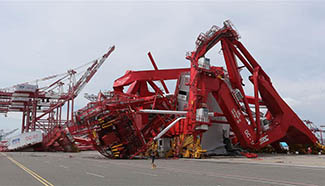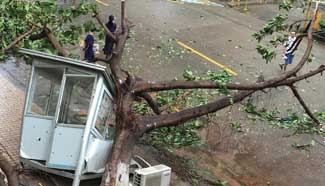
China's space lab Tiangong-2 roars into the air on the back of a Long March-2F rocket from the Jiuquan Satellite Launch Center in northwest China, Sept. 15, 2016. (Xinhua/Ju Zhenhua)
JIUQUAN, Sept. 15 (Xinhua) -- China's Tiangong-2 space lab blasted off on Thursday, marking another milestone in its increasingly ambitious space program, which envisions a mission to Mars by the end of this decade and its own space station by around 2020.
In a cloud of smoke underneath a mid-autumn full moon, Tiangong-2 roared into the air at the Jiuquan Satellite Launch Center in northwest China's Gobi desert, on the back of a Long March-2F T2 rocket at 10:04 p.m. Beijing Time.
The Long March-2F T2 is a two-stage launch vehicle that uses four strap-on boosters during its first stage.
About 20 minutes later, the mission was declared a success.
Tiangong-2 separated from the rocket and entered the preset orbit 575 seconds after blast-off, a statement from the mission control read.
While in space, the 8.6-tonne Tiangong-2 will maneuver itself into an orbit about 380 kilometers above Earth for initial in-orbit tests. It will then transfer to a slightly higher orbit of about 393 kilometers above Earth's surface.
Later, the Shenzhou-11 manned spacecraft will carry two astronauts into space to dock with the lab. The astronauts will work in the lab for 30 days before returning to Earth.
In April 2017, China's first space cargo ship Tianzhou-1, which literally means heavenly vessel, will be sent into orbit to dock with the space lab, providing fuel and other supplies.
Wu Ping, deputy director of China's manned space engineering office, said on Wednesday that experts will verify and evaluate key technologies involved with in-orbit refueling and equipment repairs, as well as those related to astronauts' long-term stay in space during the mission.
They will also use the lab, which is designed to operate for at least two years, to conduct space science experiments on a relatively large scale compared to China's previous efforts.
China's manned space program has entered a "new phase of application and development," Wu said.
DREAM LAB
Measuring 10.4 meters in length and up to 3.35 meters in diameter, the tube-like Tiangong-2 is hardly the size of a palace. But its name means heavenly palace in Chinese, and it symbolizes the dream that the Chinese have long envisioned in the sky.
Originally built as a backup to Tiangong-1, Tiangong-2 looks much like its predecessor launched in 2011, but its interior living quarters and life support system have been improved to allow longer astronaut stays.
It is designed to enable two astronauts to live in space for up to 30 days and to receive manned and cargo spaceships.
Once inside Tiangong-2, two astronauts arriving from the Shenzhou-11 spaceship will carry out key experiments related to in-orbit equipment repairs, aerospace medicine, space physics and biology, such as quantum key distribution, atomic space clocks and solar storm research.
"The number of experiments carried out by Tiangong-2 will be the highest of any manned space mission so far," said Lyu Congmin with the Chinese Academy of Sciences.
According to Zhu Zongpeng, chief designer of China's space lab system, Tiangong-2's workload includes POLAR, a collaboration between Swiss, Polish and Chinese institutions to study gamma ray bursts, the most energetic events in the universe.
A cold atomic space clock, which scientists say only loses one second in about 30 million years, is expected to make future navigation more accurate.
Scientists will also conduct a space-Earth quantum key distribution and laser communications experiment, to facilitate space-to-ground quantum communication.
Also, piggybacking on the Tiangong-2 launch will be a robotic arm that can be used for in-orbit repairs. There will also be a micro satellite that will orbit close to the space lab and snap on to Tiangong-2 and the visiting Shenzhou-11 spacecraft crew.
Earlier reports said Tiangong-2 will also carry out three experiments created by the winners of a Hong Kong middle school design contest.
"Tiangong-2 has a designed life of two years, but it is expected to work much longer than that in space," said Zhu.
Both Zhu and Wu referred to Tiangong-2 as China's first space lab "in the strict sense."
Its predecessor Tiangong-1, which docked with the Shenzhou-8, Shenzhou-9 and Shenzhou-10 spaceships and undertook a series of experiments, was mainly used to verify technology involved in space docking and serve as a simple platform for a number of scientific experiments, Wu said.
"In comparison, Tiangong-2 will boast many more experiments," said Zhu.
Tiangong-1 ended its data service earlier this year and will, reportedly, burn up as it falls into Earth's atmosphere in the latter half of 2017.
Tiangong-2 will drop into the Pacific Ocean at the end of its mission, according to the manned space engineering office.
TRAILBLAZER
The successful launch of the Tiangong-2, along with the maiden flight of China's new generation carrier rocket Long March-7 in June, bodes well for the final phase of China's three-step manned space program.
The first step, to send an astronaut into space and return safely, was fulfilled by Yang Liwei in the Shenzhou-5 mission in 2003.
The second step is developing advanced space flight techniques and technologies including extra-vehicular activity and orbital docking. This phase also includes the launch of two space laboratories - effectively mini space-stations that can be manned on a temporary basis.
Finally, the third step will be to assemble and operate a permanent manned space station.
It is expected that the space station will consist of three parts -- a core module attached to two space labs, each weighing about 20 tonnes.
According to Zhou Jianping, chief engineer of China's manned space program, one important target of Tiangong-2 is to verify technology involved in the construction of the space station.
"It has the basic technological capacity of a space station," Zhou said.
"Once the space lab mission comes to an end, China will start building our own space station," he said, adding this could start in as early as 2017.
Construction of the space station is planned for completion by around 2020.
It will enter into service around 2022, with an initial designed life of at least 10 years, Zhu Zongpeng told Xinhua. By then, astronauts could be stationed in orbit for missions that last more than one year, he added.
The Chinese space station will be much smaller than the current International Space Station (ISS), which weigh 420 tonnes, but it can be expanded for "scientific research and international cooperation," Zhou said.
With the ISS set to retire in 2024, the Chinese station will offer a promising alternative, and China will be the only country with a permanent space station.
According to Zhou, the Chinese space station will be more "economically efficient and informationized" than the ISS. It will be able to house a maximum of six astronauts at the same time and manned missions will become routine once the space station enters service.
Starting from scratch, China's ever-expanding multi-billion-dollar space program is increasingly becoming a source of national pride and a marker of technological expertise in the global community.
After launching its first manned mission in 2003, China staged a spacewalk in 2008, and sent Tiangong-1 into space in 2011.
It succeeded in a manned docking in space in 2012, becoming the third country to do so after the United States and Russia, and landed its Yutu rover on the moon a year later.
Now China is preparing Tianhe-1, a core space station module, which may be lifted by the powerful Chinese rocket Long March-5 in 2018. Additionally, Chinese scientists are making a Hubble-like telescope to orbit near the planned space station.
China also aims to send the Chang'e-5 probe to the moon and return with lunar samples in the second half of 2017, and to land a probe on Mars by 2021.
Related:
China's space lab Tiangong-2 blasts off
JIUQUAN, Sept. 15 (Xinhua) -- China on Thursday launched space lab Tiangong-2 into space, paving the way for a permanent space station the country plans to build around 2022.
In a cloud of brown smoke, Tiangong-2 roared into the air underneath a mid-autumn full moon from the Jiuquan Satellite Launch Center on the back of a Long March-2F rocket, trailing a vast volume of flame. Full story
China acquires basic technology for manned lunar missions: chief engineer
JIUQUAN, Sept. 15 (Xinhua) -- China has acquired the basic technology to carry out manned lunar missions, chief engineer of China's manned space program Zhou Jianping said Thursday.
Compared with current missions, the technology used for manned lunar missions are more complex, Zhou said. Full story
China Exclusive: China to begin building space station in 2017: chief engineer
JIUQUAN, Sept. 15 (Xinhua) -- China will begin building a space station that is more economically efficient and uses more data than the current International Space Station (ISS), starting as early as 2017, chief engineer of China's manned space program Zhou Jianping told Xinhua Thursday.
"Once the space lab mission comes to an end, China will start building our own space station," he said, adding that China will launch a core module of the space station around 2018. Full story
Tiangong-2 "another significant step" for building China's space station: U.S. experts
WASHINGTON, Sept. 15 (Xinhua) -- China on Thursday took "another significant step" towards building a manned space station around 2020 with the successful launch of its second experimental space laboratory, U.S. space experts said.
"The launch of Tiangong-2 demonstrates China remains committed to human spaceflight and to the goal of building a space station in low earth orbit," Gregory Kulacki, senior analyst and China project manager at the U.S.-based Union of Concerned Scientists' Global Security Program, told Xinhua. Full story










